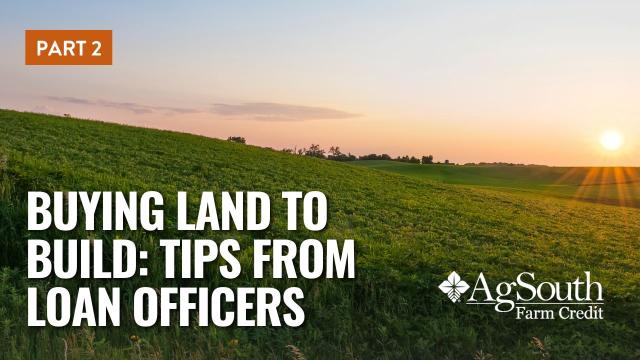Buying Land to Build a Home: Important Tips from Loan Officers Part 2

Buying Land to Build a Home: Important Tips from Loan Officers (Part 2)
When you find the perfect piece of property to build your dream home, it pays to keep in mind there are loan options available. Wanda Harris, an AgSouth Farm Credit loan officer, and Taylor Jones, a home loan originator of the AgSouth Mortgages home loan department, share some important considerations for those who have found land or are searching for land on which to build a home.
In the second installment of this two-part series, we focus on construction home loans, handled primarily by Taylor. In part one, we focus on land loans, handled primarily by Wanda.
One-Time Closing Home Construction
One of the attractive features about obtaining a construction to permanent home loan through AgSouth Mortgages, is a one-time closing.
“If someone is buying land and building a house, they are able to do a construction home loan to purchase the land and build their house,” says Taylor. “That is all part of one loan. That one-time closing feature is going to save a good amount of money in closing costs, particularly when you compare it to someone who may be considering buying land and then waiting a year or two to build.”
With a construction to permanent loan, AgSouth Farm Credit offers up to 95 percent financing so expect to pay at least 5 percent down. “That 5 percent is based on the cost of the land and the cost to build if you are purchasing land as opposed to appraisal value when someone wants to build on land they already own,” explains Taylor. “We also have a jumbo construction to permanent program that finances up to $2,999,999 but with that comes a 20 percent down payment due to us taking on larger risk.”
While circumstances at times may not warrant immediate construction of a home, if you are ready to build it may pay to wrap the land purchase and construction loan into one. In addition to one closing, Taylor explains that during the approval process, the interest rate is locked in. AgSouth Mortgages then gives customers 12 months to build their house and that rate is guaranteed from closing through the 12 months. “We can reduce that rate if rates happen to be better at the time the loan is converted from the construction phase to the permanent phase of the loan, but we will not go above the locked-in rate. That’s huge because rates can fluctuate,” says Taylor. “It’s a big selling point.”
So, too, is the modification process, when converting from the construction phase to the permanent phase of the loan. “It’s so easy because you don’t have to go back to an attorney so it saves a lot of time and trouble,” says Taylor. “It’s straightforward. We don’t re pull credit; we don’t ask for pay stubs and information on assets again.” Typically, home loans are 30-year fixed loans, though 15-year fixed are an option. Even though they are called 30-year fixed loans, technically they are 31-year loans because customers have a year to build before it is converted to the 30-year loan.
What Do You Need to Start a Construction to Permanent Loan?
Taylor says it’s helpful to have an idea of the land cost and the cost to build. With this information he can begin the preapproval process for a loan. In order to start a formal application, we will need a signed contract with your builder, construction plans and specifications, and a copy of the deed for the land (or the contract for purchase if you’re buying land at the same time).
Taylor shares that in some instances people are not ready to build but they do want to purchase land to build a home in the future.
In part one of this series, “Buying Land to Build a Home,” AgSouth Farm Credit loan officer Wanda Harris shares scenarios when going the land loan route may be the best option for you to secure your dream property when you find it.